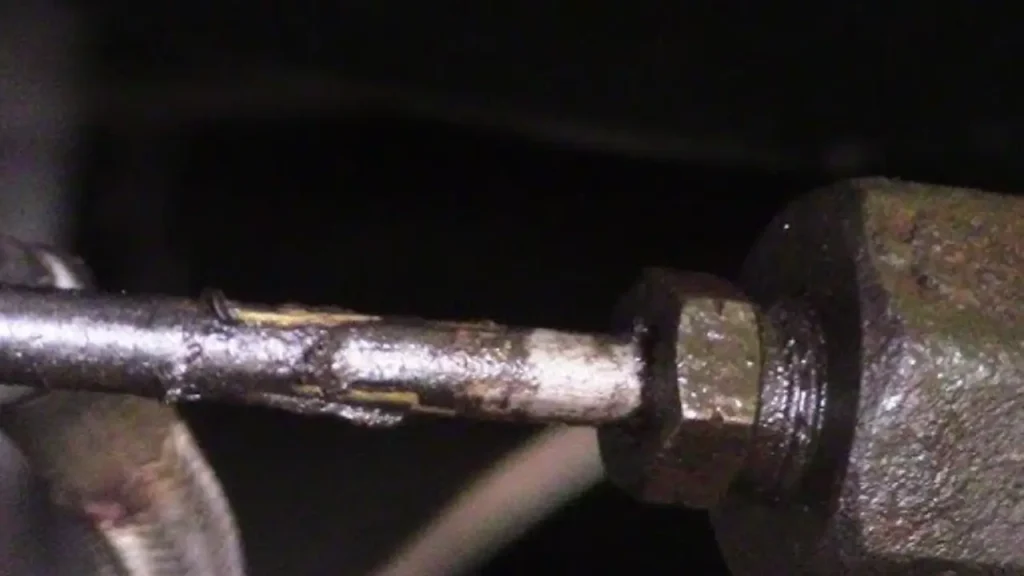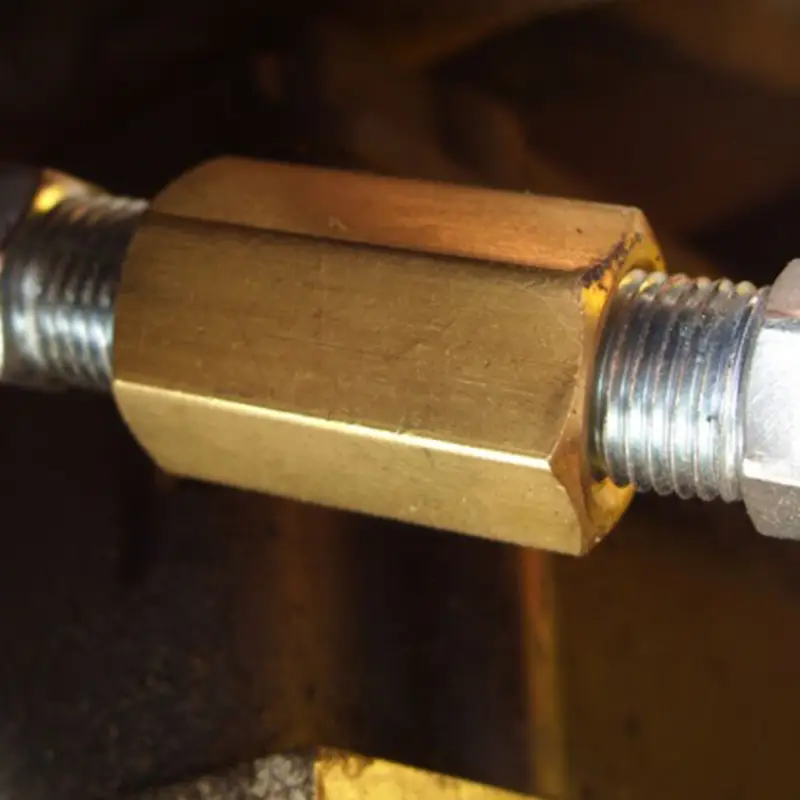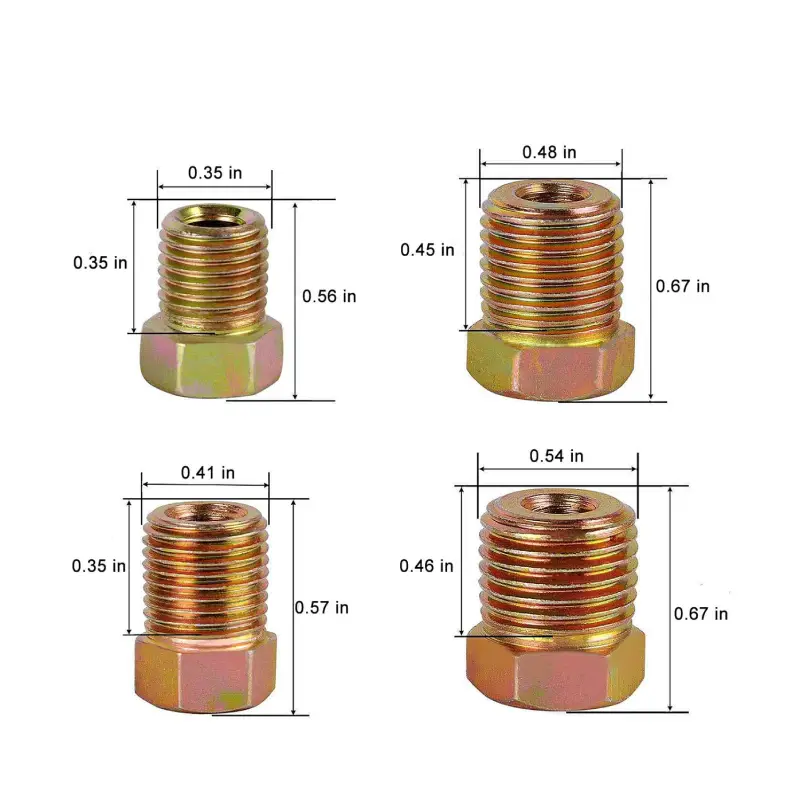Dealing with rusted brake line fittings can be a frustrating but necessary task when maintaining your vehicle’s braking system. Rust can severely seize these fittings, making them incredibly difficult to remove without causing damage. This guide aims to provide you with safe and effective methods to tackle this issue, ensuring you can restore your brake lines without costly replacements.
Removing rusted brake line fittings requires patience and the right tools. We’ll explore various techniques, from using penetrating oils to applying heat, and even cutting the fitting as a last resort. Each method is designed to minimize damage and ensure you can safely disconnect the brake lines. By following these steps, you can confidently remove rusted fittings and maintain your vehicle’s braking system.
How to Remove Rusted Brake Line Fittings?

Removing rusted brake line fittings can be a challenging task, but it’s essential for maintaining your vehicle’s braking system. Rust can seize fittings, making them difficult to loosen and prone to damage. This guide outlines the steps to safely remove rusted brake line fittings.
Step 1: Apply Penetrating Oil
Begin by thoroughly applying a high-quality penetrating oil to the rusted brake line fitting and surrounding area. Allow the oil to soak for at least 15-30 minutes, or even overnight for heavily rusted fittings. The penetrating oil helps to break down the rust and loosen the fitting, making it easier to remove.
You should give the penetrating oil ample time to work its way into the rusted threads. Avoid rushing this step, as it can significantly reduce the risk of damaging the brake line or fitting. For severe rust, consider applying penetrating oil multiple times over several hours or overnight. This allows the oil to fully penetrate and loosen the rust.
Step 2: Use a Flare Nut Wrench
Once the penetrating oil has soaked, use a flare nut wrench (line wrench) to attempt to loosen the rusted fitting. This wrench is designed to grip the fitting securely and minimize the risk of rounding the corners. Apply steady, even pressure and avoid excessive force, as this can damage the fitting or brake line. If the fitting is still stubborn, gently tap it with a hammer to help break the rust’s grip.
You should always use a flare nut wrench for brake line fittings, as standard wrenches are more likely to damage them. Apply consistent pressure and avoid jerky movements, which can cause the fitting to break. If tapping with a hammer, use light, controlled taps to avoid damaging the brake line. If the fitting refuses to budge, repeat the penetrating oil application.
Step 3: Heat the Fitting (If Necessary)
If the fitting is still seized, carefully apply heat to the rusted area using a propane torch or heat gun. Heat can help expand the metal and break the rust’s bond. Apply heat evenly and avoid overheating, as this can damage the brake line or fitting. After heating, reapply penetrating oil and attempt to loosen the fitting with a flare nut wrench.
You should exercise extreme caution when applying heat to brake line fittings. Avoid using excessive heat, which can damage the brake line or surrounding components. Apply heat in short bursts and move the torch or heat gun around the fitting to ensure even heating. After heating, allow the fitting to cool slightly before attempting to loosen it. This helps prevent damage to the fitting or brake line.
Step 4: Consider Cutting the Fitting
If all other methods fail, you may need to cut the rusted fitting off. Use a rotary tool or hacksaw to carefully cut through the fitting, avoiding damage to the brake line. Once the fitting is cut, you can remove the remaining pieces and clean the threads. This method should be used as a last resort, as it requires replacing the fitting or brake line.
You should proceed with caution when cutting the fitting to avoid damaging the brake line. Make clean, precise cuts and avoid applying excessive force. After cutting, carefully remove any remaining pieces of the fitting and clean the threads on the brake line. You will then need to replace the fitting, and potentially the brake line.
What Casues Rusted Brake Line Fittings
Rusted brake line fittings are a common issue, especially in vehicles exposed to harsh environments. Understanding the causes of this rust is crucial for preventative maintenance and ensuring the longevity of your braking system. Here are the primary factors contributing to rusted brake line fittings:
Environmental Exposure
Exposure to moisture, road salt, and other corrosive elements is a significant cause of rust on brake line fittings. Vehicles operating in areas with heavy snowfall or coastal regions are particularly susceptible. Road salt, used to melt ice and snow, is highly corrosive and can accelerate the rusting process. Similarly, high humidity and moisture contribute to rust formation over time.
Material Composition
The material composition of the brake line fittings also plays a role in their susceptibility to rust. Fittings made from less corrosion-resistant materials, such as standard steel, are more prone to rusting than those made from stainless steel or brass. Even with protective coatings, prolonged exposure to harsh conditions can degrade these coatings, leaving the underlying metal vulnerable to rust.
Lack of Maintenance
Insufficient maintenance can exacerbate the issue of rusted brake line fittings. Neglecting regular inspections and cleaning can allow rust to develop and spread unchecked. Brake fluid leaks, which can occur due to damaged fittings, can also contribute to rust formation by attracting and holding moisture. Regular cleaning and application of protective coatings can help prevent rust and prolong the life of brake line fittings.
How to Prevent Rusted Brake Line Fittings

Preventing rusted brake line fittings is crucial for maintaining the integrity and safety of your vehicle’s braking system. Implementing proactive measures can significantly extend the lifespan of these components and avoid costly repairs. Here’s how you can protect your brake line fittings from rust:
Regular Cleaning and Inspection
Regularly cleaning your vehicle’s undercarriage, particularly after exposure to road salt or harsh weather conditions, can significantly reduce the risk of rust. Inspecting brake line fittings for signs of corrosion or damage during routine maintenance checks allows for early detection and intervention. Cleaning removes corrosive substances before they can cause significant damage.
Protective Coatings
Applying protective coatings to brake line fittings can create a barrier against moisture and corrosive elements. Products like rust inhibitors or specialized protective sprays can shield the fittings from environmental damage. Ensure the coatings are compatible with the fitting material and are reapplied periodically, especially after exposure to harsh conditions.
Material Upgrades
When replacing brake line fittings, consider upgrading to materials that offer better corrosion resistance. Stainless steel or brass fittings are less prone to rusting compared to standard steel fittings. While they may have a higher initial cost, they provide long-term protection and reduce the need for frequent replacements. Avoiding lower quality fittings, will help ensure long term reliability.
Proper Brake Fluid Maintenance
Maintaining proper brake fluid levels and ensuring the fluid is free of contaminants can also help prevent rust. Brake fluid that is contaminated or has absorbed moisture can contribute to corrosion. Regularly flushing and replacing the brake fluid according to manufacturer recommendations helps maintain a healthy braking system.
How to Loosen Brake Line Fittings
Loosening brake line fittings can be a delicate task, especially if they are rusted or corroded. Improper techniques can damage the fittings or brake lines, leading to leaks and compromised braking performance. This guide outlines the steps to safely loosen brake line fittings.
Step 1: Prepare the Fittings
Before attempting to loosen the fittings, clean any dirt, debris, or rust from the area. Apply a penetrating oil to the threads and allow it to soak for at least 15-30 minutes, or longer for heavily corroded fittings. This helps to break down rust and loosen the fitting. Proper preparation minimizes the risk of damage during removal.
Cleaning the fittings ensures you have a clear view of the connection and prevents debris from entering the braking system. Penetrating oil is crucial for loosening rusted fittings, reducing the force required and minimizing the risk of damage. Allowing sufficient soak time ensures the oil penetrates the threads effectively.
Step 2: Use a Flare Nut Wrench
Use a flare nut wrench, also known as a line wrench, to loosen the brake line fitting. This wrench is designed to grip the fitting securely and prevent rounding the corners, which can happen with standard wrenches. Apply steady, even pressure and avoid excessive force. If the fitting is stubborn, gently tap it with a hammer to help break the rust’s grip.
A flare nut wrench provides a secure grip, distributing force evenly across the fitting. This prevents damage and ensures a better chance of loosening the fitting without rounding the corners. Applying steady pressure prevents sudden movements that can break the fitting or brake line. Gentle tapping can help break the rust’s bond without causing damage.
Step 3: Heat the Fitting (If Necessary)
If the fitting remains seized, carefully apply heat to the rusted area using a propane torch or heat gun. Heat can help expand the metal and break the rust’s bond. Apply heat evenly and avoid overheating, as this can damage the brake line or surrounding components. After heating, reapply penetrating oil and attempt to loosen the fitting with a flare nut wrench.
Heating should be used as a last resort, as it carries risks. Even heating prevents localized damage and ensures the metal expands evenly. Avoid overheating, which can weaken the metal or damage surrounding components. Reapplying penetrating oil after heating helps it penetrate the loosened rust.
Step 4: Cut the Fitting (As a Last Resort)
If all other methods fail, you may need to cut the fitting. Use a rotary tool or hacksaw to carefully cut through the fitting, avoiding damage to the brake line. Once the fitting is cut, you can remove the remaining pieces and clean the threads. This method should be used only when all other options have been exhausted, as it requires replacing the fitting or brake line.
Cutting the fitting is a last resort due to the risk of damaging the brake line. Make clean, precise cuts to minimize damage. Cleaning the threads after cutting ensures a smooth surface for the new fitting. Replacing the fitting or brake line ensures the integrity of the braking system.
Conclusion
In conclusion, removing rusted brake line fittings requires patience and precision to avoid damaging the brake lines or surrounding components. Applying penetrating oil, using a flare nut wrench, and, if necessary, carefully applying heat are essential steps. When all else fails, cutting the fitting becomes a last resort, demanding extra caution.
Proper removal techniques ensure the integrity of your braking system, crucial for vehicle safety. Rushing the process or applying excessive force can lead to costly brake line fitting repairs and compromised performance. Regular maintenance and timely intervention can prevent severe rusting, making future removals easier.
For high-quality wholesale hydraulic hose fittings, including those suitable for brake lines, request a quote from DF Hydraulics today. We offer a comprehensive range of durable and reliable fittings, ensuring secure and efficient connections. Get in touch to discuss your requirements and benefit from our expert services.



